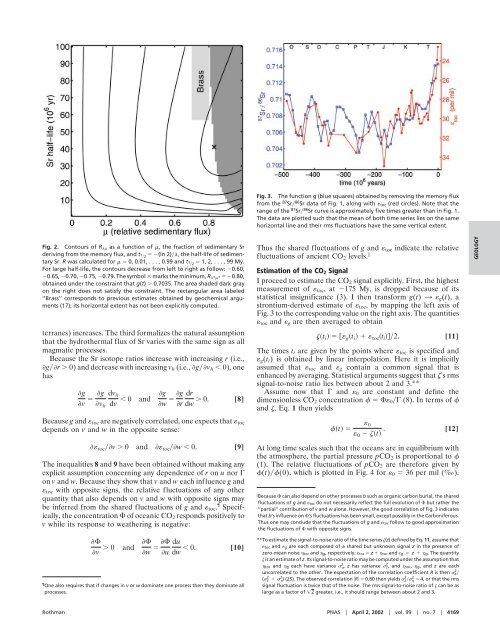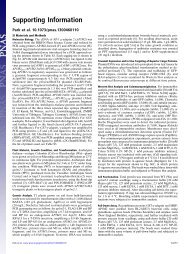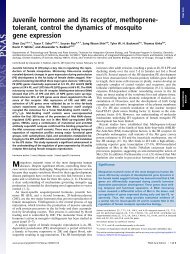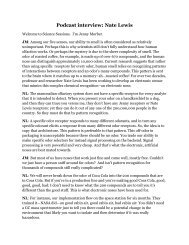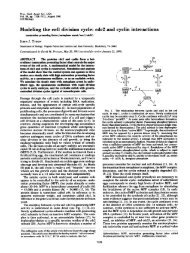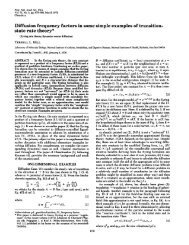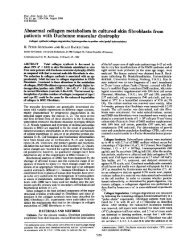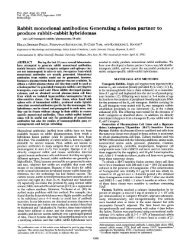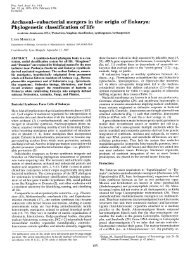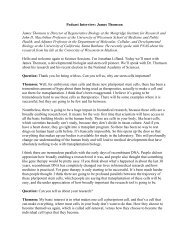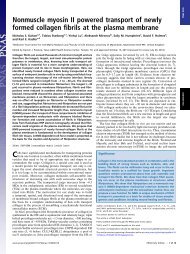Atmospheric carbon dioxide levels for the last 500 million years
Atmospheric carbon dioxide levels for the last 500 million years
Atmospheric carbon dioxide levels for the last 500 million years
You also want an ePaper? Increase the reach of your titles
YUMPU automatically turns print PDFs into web optimized ePapers that Google loves.
Fig. 3. The function g (blue squares) obtained by removing <strong>the</strong> memory flux<br />
from <strong>the</strong> 87 Sr 86 Sr data of Fig. 1, along with toc (red circles). Note that <strong>the</strong><br />
range of <strong>the</strong> 87 Sr 86 Sr curve is approximately five times greater than in Fig. 1.<br />
The data are plotted such that <strong>the</strong> mean of both time series lies on <strong>the</strong> same<br />
horizontal line and <strong>the</strong>ir rms fluctuations have <strong>the</strong> same vertical extent.<br />
Thus <strong>the</strong> shared fluctuations of g and toc indicate <strong>the</strong> relative<br />
Fig. 2. Contours of R as a function of , <strong>the</strong> fraction of sedimentary Sr<br />
<br />
<br />
0 and<br />
v w du<br />
u dw 0. [10]<br />
deriving from <strong>the</strong> memory flux, and t1 2<br />
(ln 2), <strong>the</strong> half-life of sedimentary<br />
fluctuations of ancient CO 2 <strong>levels</strong>. <br />
Sr. R was calculated <strong>for</strong> 0, 0.01, ...,0.99 and t1 2 1,2,...,99My. For large half-life, <strong>the</strong> contours decrease from left to right as follow: 0.60, Estimation of <strong>the</strong> CO 2 Signal<br />
0.65, 0.70, 0.75, 0.79. The symbol marks <strong>the</strong> minimum, R ** 0.80,<br />
obtained under <strong>the</strong> constraint that g(t) 0.7035. The area shaded dark gray I proceed to estimate <strong>the</strong> CO 2 signal explicitly. First, <strong>the</strong> highest<br />
on <strong>the</strong> right does not satisfy <strong>the</strong> constraint. The rectangular area labeled measurement of toc ,at175 My, is dropped because of its<br />
‘‘Brass’’ corresponds to previous estimates obtained by geochemical arguments<br />
statistical insignificance (3). I <strong>the</strong>n trans<strong>for</strong>m g(t) 3 g (t), a<br />
(17); its horizontal extent has not been explicitly computed.<br />
strontium-derived estimate of toc , by mapping <strong>the</strong> left axis of<br />
Fig. 3 to <strong>the</strong> corresponding value on <strong>the</strong> right axis. The quantities<br />
toc and g are <strong>the</strong>n averaged to obtain<br />
terranes) increases. The third <strong>for</strong>malizes <strong>the</strong> natural assumption<br />
that <strong>the</strong> hydro<strong>the</strong>rmal flux of Sr varies with <strong>the</strong> same sign as all<br />
t i g t i toc t i 2. [11]<br />
magmatic processes.<br />
Because <strong>the</strong> Sr isotope ratios increase with increasing r (i.e.,<br />
The times t i are given by <strong>the</strong> points where toc is specified and<br />
g (t i ) is obtained by linear interpolation. Here it is implicitly<br />
gr 0) and decrease with increasing v h (i.e., gv h 0), one assumed that toc and g contain a common signal that is<br />
has<br />
enhanced by averaging. Statistical arguments suggest that ’srms<br />
signal-to-noise ratio lies between about 2 and 3.**<br />
g<br />
v g dv h<br />
v h dv 0 and g<br />
w g dr<br />
Assume now that and 0 are constant and define <strong>the</strong><br />
0. [8] dimensionless CO<br />
r dw 2 concentration 0 (8). In terms of <br />
and , Eq. 1 <strong>the</strong>n yields<br />
Because g and toc are negatively correlated, one expects that toc<br />
depends on v and w in <strong>the</strong> opposite sense:<br />
0<br />
t <br />
0 t . [12]<br />
toc v 0 and toc w 0. [9] At long time scales such that <strong>the</strong> oceans are in equilibrium with<br />
<strong>the</strong> atmosphere, <strong>the</strong> partial pressure pCO 2 is proportional to <br />
The inequalities 8 and 9 have been obtained without making any<br />
explicit assumption concerning any dependence of r on u nor <br />
(1). The relative fluctuations of pCO 2 are <strong>the</strong>re<strong>for</strong>e given by<br />
(t)(0), which is plotted in Fig. 4 <strong>for</strong> 0 36 per mil (‰).<br />
on v and w. Because <strong>the</strong>y show that v and w each influence g and<br />
toc with opposite signs, <strong>the</strong> relative fluctuations of any o<strong>the</strong>r<br />
quantity that also depends on v and w with opposite signs may<br />
Because can also depend on o<strong>the</strong>r processes b such as organic <strong>carbon</strong> burial, <strong>the</strong> shared<br />
fluctuations of g and toc do not necessarily reflect <strong>the</strong> full evolution of but ra<strong>the</strong>r <strong>the</strong><br />
be inferred from <strong>the</strong> shared fluctuations of g and toc . Specifically,<br />
<strong>the</strong> concentration of oceanic CO 2 responds positively to<br />
v while its response to wea<strong>the</strong>ring is negative:<br />
‘‘partial’’ contribution of v and w alone. However, <strong>the</strong> good correlation of Fig. 3 indicates<br />
that b’sinfluence on ’s fluctuations has been small, except possibly in <strong>the</strong> Carboniferous.<br />
Thus one may conclude that <strong>the</strong> fluctuations of g and toc follow to good approximation<br />
<strong>the</strong> fluctuations of with opposite signs.<br />
One also requires that if changes in v or w dominate one process <strong>the</strong>n <strong>the</strong>y dominate all<br />
processes.<br />
**To estimate <strong>the</strong> signal-to-noise ratio of <strong>the</strong> time series (t)defined by Eq. 11, assume that<br />
toc and g are each composed of a shared but unknown signal z in <strong>the</strong> presence of<br />
zero-mean noise toc and g, respectively: toc z toc and g z g. The quantity<br />
is an estimate of z. Its signal-to-noise ratio may be computed under <strong>the</strong> assumption that<br />
toc and g each have variance 2 , z has variance z 2 , and toc, g, and z are each<br />
uncorrelated to <strong>the</strong> o<strong>the</strong>r. The expectation of <strong>the</strong> correlation coefficient R is <strong>the</strong>n z 2 <br />
( z 2 2 ) (25). The observed correlation R 0.80 <strong>the</strong>n yields z 2 2 4, or that <strong>the</strong> rms<br />
signal fluctuation is twice that of <strong>the</strong> noise. The rms signal-to-noise ratio of can be as<br />
large as a factor of 2 greater, i.e., it should range between about 2 and 3.<br />
GEOLOGY<br />
Rothman PNAS April 2, 2002 vol. 99 no. 7 4169


